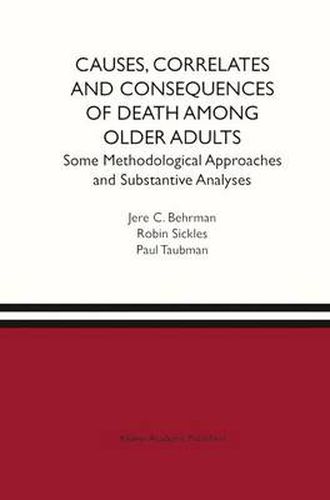Readings Newsletter
Become a Readings Member to make your shopping experience even easier.
Sign in or sign up for free!
You’re not far away from qualifying for FREE standard shipping within Australia
You’ve qualified for FREE standard shipping within Australia
The cart is loading…






This title is printed to order. This book may have been self-published. If so, we cannot guarantee the quality of the content. In the main most books will have gone through the editing process however some may not. We therefore suggest that you be aware of this before ordering this book. If in doubt check either the author or publisher’s details as we are unable to accept any returns unless they are faulty. Please contact us if you have any questions.
All humans eventually die, but life expectancies differ over time and among different demographic groups. Teasing out the various causes and correlates of death is a challenge, and it is one we take on in this book. A look at the data on mortality is both interesting and suggestive of some possible relationships. In 1900 life expectancies at birth were 46. 3 and 48. 3 years for men and women respectively, a gender differential of a bit less than 5 percent. Life expectancies for whites then were about 0. 3 years longer than that of the whole population, but life expectancies for blacks were only about 33 years for men and women. At age 65, the remaining life expectancies were about 12 and 11 years for whites and blacks respectively. Fifty years later, life expectancies at birth had grown to 66 and 71 years for males and females respectively. The percentage differential between the sexes was now almost up to 10 percent. The life expectancies of whites were about one year longer than that for the entire population. The big change was for blacks, whose life expectancy had grown to over 60 years with black females living about 5 percent longer than their male counterparts. At age 65 the remaining expected life had increased about two years with much larger percentage gains for blacks.
$9.00 standard shipping within Australia
FREE standard shipping within Australia for orders over $100.00
Express & International shipping calculated at checkout
This title is printed to order. This book may have been self-published. If so, we cannot guarantee the quality of the content. In the main most books will have gone through the editing process however some may not. We therefore suggest that you be aware of this before ordering this book. If in doubt check either the author or publisher’s details as we are unable to accept any returns unless they are faulty. Please contact us if you have any questions.
All humans eventually die, but life expectancies differ over time and among different demographic groups. Teasing out the various causes and correlates of death is a challenge, and it is one we take on in this book. A look at the data on mortality is both interesting and suggestive of some possible relationships. In 1900 life expectancies at birth were 46. 3 and 48. 3 years for men and women respectively, a gender differential of a bit less than 5 percent. Life expectancies for whites then were about 0. 3 years longer than that of the whole population, but life expectancies for blacks were only about 33 years for men and women. At age 65, the remaining life expectancies were about 12 and 11 years for whites and blacks respectively. Fifty years later, life expectancies at birth had grown to 66 and 71 years for males and females respectively. The percentage differential between the sexes was now almost up to 10 percent. The life expectancies of whites were about one year longer than that for the entire population. The big change was for blacks, whose life expectancy had grown to over 60 years with black females living about 5 percent longer than their male counterparts. At age 65 the remaining expected life had increased about two years with much larger percentage gains for blacks.